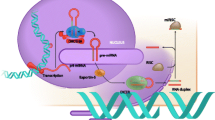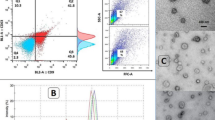Abstract
Acute graft-versus-host disease (aGVHD) is one of the major causes of morbidity and mortality in patients receiving allogeneic hematopoietic cell transplantation (allo-HSCT). MicroRNAs (miRs) were found to have the potential to be the new biomarkers of aGVHD. In this study, we collected samples from 98 patients who underwent allo-HSCT; 63 patients developed aGVHD, and 35 patients did not. Plasma samples were collected at three time points (before aGVHD, at the onset of aGVHD, and after aGVHD) from 52 patients, and the miR-586 expression level was detected by quantitative real-time PCR. We found that the plasma miR-586 level was decreased at the onset of grade I–II aGVHD (P = 0.074). In contrast, when infections were detected, plasma miR-586 level was increased. Moreover, we detected the miR-586 expression level in patients who had infections but did not have aGVHD, and we found that miR-586 was upregulated (P = 0.005). We also compared the plasma miR-586 level at day 7 after transplantation between aGVHD patients and control patients. In the aGVHD group, there was a considerably higher miR-586 expression in comparison with the non-aGVHD group (P < 0.05). A more significant difference between the two groups was found when the patients with infections were excluded (P = 0.004). Furthermore, receive operating characteristic (ROC) analysis indicated that a higher expression level of miR-586 at day 7 could predict impending aGVHD. The optimal cutoff value of miR-586 to predict aGVHD was 2200 copies/μL with a sensitivity of 87.5 % and specificity of 55.0 %, and the area under the curve (AUC) was 0.739 (95 % CI 0.598–0.880, P = 0.004). Our study suggests that miR-586 might participate in the occurrence of aGVHD and could be a putative target for novel aGVHD therapy. The plasma level of miR-586 at day 7 after allo-HSCT would be a potential biomarker for predicting the occurrence of aGVHD.



Similar content being viewed by others

References
Ferrara JL, Levine JE, Reddy P, Holler E (2009) Graft-versus-host disease. Lancet 373:1550–1561
Paczesny S (2013) Discovery and validation of graft-versus-host disease biomarkers. Blood 121:585–594
Friedman RC, Farh KK, Burge CB, Bartel DP (2009) Most mammalian mRNAs are conserved targets of microRNAs. Genome Res 19:92–105
Atarod S, Dickinson AM (2013) MicroRNAs: the missing link in the biology of graft-versus-host disease? Front Immunol 4
Ranganathan P, Heaphy CE, Costinean S et al (2012) Regulation of acute graft-versus-host disease by microRNA-155. Blood 119:4786–4797
Xiao B, Wang Y, Li W et al (2013) Plasma microRNA signature as a noninvasive biomarker for acute graft-versus-host disease. Blood 122:3365–3375
Leonhardt F, Grundmann S, Behe M et al (2013) Inflammatory neovascularization during graft-versus-host disease is regulated by αv integrin and miR-100. Blood 121:3307–3318
Wang L, Romero M, Ratajczak P et al (2013) Increased apoptosis is linked to severe acute GVHD in patients with Fanconi anemia. Bone Marrow Transplant 48:849–853
Stickel N, Prinz G, Pfeifer D et al (2014) MiR-146a regulates the TRAF6/TNF-axis in donor T cells during GVHD. Blood 124:2586–2595
Atarod S, Dickinson AM (2013) MicroRNAs: the missing link in the biology of graft-versus-host disease? Front Immunol 4:420
Thomas ED Sr (1994) Stem cell transplantation: past, present and future. Stem Cells 12:539–544
Zhao XS, Liu KY, Liu DH et al (2011) Potential immunosuppressive function of plasma indoleamine 2,3-dioxygenase in patients with aGVHD after allo-HSCT. Clin Transplant 25:E304–E311
Kroh EM, Parkin RK, Mitchell PS, Tewari M (2010) Analysis of circulating microRNA biomarkers in plasma and serum using quantitative reverse transcription-PCR (qRT-PCR). Methods 50:298–301
Mitchell PS, Parkin RK, Kroh EM et al (2008) Circulating microRNAs as stable blood-based markers for cancer detection. Proc Natl Acad Sci U S A 105:10513–10518
Chen X, Ba Y, Ma L et al (2008) Characterization of microRNAs in serum: a novel class of biomarkers for diagnosis of cancer and other diseases. Cell Res 18:997–1006
Gilad S, Meiri E, Yogev Y et al (2008) Serum microRNAs are promising novel biomarkers. PLoS One 3:e3148
Heneghan HM, Miller N, Lowery AJ et al (2010) Circulating microRNAs as novel minimally invasive biomarkers for breast cancer. Ann Surg 251:499–505
Lawrie CH, Gal S, Dunlop HM et al (2008) Detection of elevated levels of tumour-associated microRNAs in serum of patients with diffuse large B-cell lymphoma. Br J Haematol 141:672–675
Lodes MJ, Caraballo M, Suciu D et al (2009) Detection of cancer with serum miRNAs on an oligonucleotide microarray. PLoS One 4:e6229
Ng EK, Chong WW, Jin H et al (2009) Differential expression of microRNAs in plasma of patients with colorectal cancer: a potential marker for colorectal cancer screening. Gut 58:1375–1381
Sanchez-Jimenez C, Carrascoso I, Barrero J, Izquierdo JM (2013) Identification of a set of miRNAs differentially expressed in transiently TIA-depleted HeLa cells by genome-wide profiling. BMC Mol Biol 14:4
Lau J, Sartor M, Bradstock KF et al (2007) Activated circulating dendritic cells after hematopoietic stem cell transplantation predict acute graft-versus-host disease. Transplantation 83:839–846
Magenau JM, Qin X, Tawara I et al (2010) Frequency of CD4(+)CD25(hi)FOXP3(+) regulatory T cells has diagnostic and prognostic value as a biomarker for acute graft-versus-host-disease. Biol Blood Marrow Transplant 16:907–914
Teshima T, Maeda Y, Ozaki K (2011) Regulatory T cells and IL-17-producing cells in graft-versus-host disease. Immunotherapy 3:833–852
Zinocker S, Sviland L, Dressel R, Rolstad B (2011) Kinetics of lymphocyte reconstitution after allogeneic bone marrow transplantation: markers of graft-versus-host disease. J Leukoc Biol 90:177–187
Hori T, Naishiro Y, Sohma H et al (2008) CCL8 is a potential molecular candidate for the diagnosis of graft-versus-host disease. Blood 111:4403–4412
Foley R, Couban S, Walker I et al (1998) Monitoring soluble interleukin-2 receptor levels in related and unrelated donor allogenic bone marrow transplantation. Bone Marrow Transplant 21:769–773
Grimm J, Zeller W, Zander AR (1998) Soluble interleukin-2 receptor serum levels after allogeneic bone marrow transplantations as a marker for GVHD. Bone Marrow Transplant 21:29–32
Mathias C, Mick R, Grupp S et al (2000) Soluble interleukin-2 receptor concentration as a biochemical indicator for acute graft-versus-host disease after allogeneic bone marrow transplantation. J Hematother Stem Cell Res 9:393–400
Miyamoto T, Akashi K, Hayashi S et al (1996) Serum concentration of the soluble interleukin-2 receptor for monitoring acute graft-versus-host disease. Bone Marrow Transplant 17:185–190
Choi SW, Kitko CL, Braun T et al (2008) Change in plasma tumor necrosis factor receptor 1 levels in the first week after myeloablative allogeneic transplantation correlates with severity and incidence of GVHD and survival. Blood 112:1539–1542
Holler E, Kolb HJ, Moller A et al (1990) Increased serum levels of tumor necrosis factor alpha precede major complications of bone marrow transplantation. Blood 75:1011–1016
Or R, Kalinkovich A, Nagler A et al (1996) Soluble tumor necrosis factor (sTNF) receptors: a possible prognostic marker for bone marrow transplantation-related complications. Cytokines Mol Ther 2:243–250
Luft T, Conzelmann M, Benner A et al (2007) Serum cytokeratin-18 fragments as quantitative markers of epithelial apoptosis in liver and intestinal graft-versus-host disease. Blood 110:4535–4542
Okamoto T, Takatsuka H, Fujimori Y et al (2001) Increased hepatocyte growth factor in serum in acute graft-versus-host disease. Bone Marrow Transplant 28:197–200
Seidel C, Ringden O, Remberger M (2003) Increased levels of syndecan-1 in serum during acute graft-versus-host disease. Transplantation 76:423–426
Kosaka N, Iguchi H, Yoshioka Y et al (2010) Secretory mechanisms and intercellular transfer of microRNAs in living cells. J Biol Chem 285:17442–17452
Vickers KC, Palmisano BT, Shoucri BM et al (2011) MicroRNAs are transported in plasma and delivered to recipient cells by high-density lipoproteins. Nat Cell Biol 13:423–433
Wang GK, Zhu JQ, Zhang JT et al (2010) Circulating microRNA: a novel potential biomarker for early diagnosis of acute myocardial infarction in humans. Eur Heart J 31:659–666
O’Connell RM, Taganov KD, Boldin MP et al (2007) MicroRNA-155 is induced during the macrophage inflammatory response. Proc Natl Acad Sci U S A 104:1604–1609
Xie LN, Zhou F, Liu XM et al (2014) Serum microRNA155 is increased in patients with acute graft-versus-host disease. Clin Transplant 28:314–323
Bala S, Tilahun Y, Taha O et al (2012) Increased microRNA-155 expression in the serum and peripheral monocytes in chronic HCV infection. J Transl Med 10:151
Acknowledgments
We would like to thank the Shenzhen Biomedical Research Support Platform and the Shenzhen Molecular Diagnostic Platform of Dermatology for their technical help. This work was supported by the National Natural Scientific Foundation of China (Grant Nos. 81000465, 81171017, and 81300440), Shenzhen Basic Research Grants (Grant Nos. GJHZ20120616153140827 and JCYJ20120616153316095), the Peacock Plan Research Grant (Grant No. KQC201105300001A), and the Beijing Natural Science Foundation (Grant No. 7132181). The funders had no contribution to the study design, data collection and analysis, decision to publish, or preparation of the manuscript.
Conflict of interest
The authors declare that they have no conflict of interest.
Author information
Authors and Affiliations
Corresponding authors
Additional information
Yinuo Wang, Xiaosu Zhao, Xiaojun Huang and Jun Wan contributed equally to this work.
Rights and permissions
About this article
Cite this article
Wang, Y., Zhao, X., Ye, X. et al. Plasma microRNA-586 is a new biomarker for acute graft-versus-host disease. Ann Hematol 94, 1505–1514 (2015). https://doi.org/10.1007/s00277-015-2414-z
Received:
Accepted:
Published:
Issue Date:
DOI: https://doi.org/10.1007/s00277-015-2414-z



